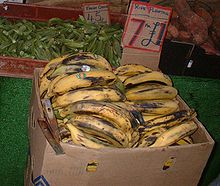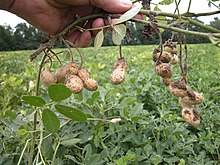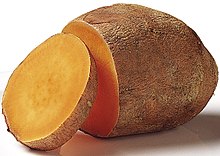Ghanaian cuisine
In the past, Ghanaian cuisine was subject to many influences. Many ingredients in Ghanaian cuisine only became known in Ghana during the colonial era or later . Typical for this are tomato paste, stock cubes or milk powder. There are also regional differences in Ghana, as the people in Ghana, especially in the rural areas, have adapted their food to the offer in the local garden and neither want nor can buy imported goods from the city.
Components of the food culture
The meals are rather heavy, the main ingredient is usually a filling base such as rice , fufu , semolina , yams , banku , kenkey , sweet potato or plantain , which is usually only served with a sauce. Ghana is particularly on the coast and near the Volta Lake often happy and fish eaten, because it is to buy in most regions at a low price. Ghanaians also like to eat meat dishes. The meat is often cooked in the sauce and served with it. However, meat is comparatively expensive, so that not every Ghanaian can afford game meat or beef every day. Chicken is more common because it is cheaper to get.
The meat is almost always slaughtered fresh, often by the chefs themselves to ensure freshness. Due to the tropical climate, as refrigerators are rare in the country and due to high energy prices, especially in the cities, the traditional in-house slaughter has continued to this day. Pork is seldom found in Ghana, because the not inconsiderable Muslim population in Ghana does not eat it for religious reasons. The wild boar has not been domesticated in Ghana either. The pig farms, which are almost only located in the south, make good sales, but pork has so far only been very slow to establish itself. A different development is already becoming apparent, however, since pig breeding is of considerable economic interest due to the very high rate of reproduction of the animals compared to cattle or sheep , which usually do not give birth to more than 1–2 young animals.
Vegetables are not an essential part of Ghanaian cuisine. Salad is sometimes served as a small side dish in restaurants or the typical Ghanaian chop bars (street kitchens ) or in private areas on special occasions. Otherwise, lettuce is rare in private, but it happens when a head of lettuce is just ready to be harvested in the garden. Often, however, onions and tomatoes are used , often as imported tomato paste , but often also as fresh fruit. Unlike in Europe , the vegetables are not added to the meal shortly before the end of the cooking time, but are always fried as tomato paste with the oil and onions at the beginning. Food is generally cooked for a long time, and under no circumstances does a Ghanaian eat meat that is seared or bloody.
Eating habits
The eating habits in Ghana differ between urban and rural populations, but also within the various ethnic groups. The staple foods such as rice, fufu, plantain or banku are used by everyone, but the sauces, side dishes and spices are partly different. There is also a slight focus on the use of staple foods, especially in rural areas. Here, due to the sometimes long transport routes, preference is given to the staple food that has its preferred growing area in the residential area of the population. In the south, tuberous fruits such as sweet potatoes or cassava are used, whereas in the arid north the tuberous yams are mainly grown, but grains such as semolina , millet , corn and rice are also used more frequently here. In the north, meat is eaten almost exclusively, unless there is a river nearby that offers a variety of fish, while fish is mainly in the Volta Basin and on the coast.
In Ghana, people traditionally eat with their fingers. Therefore, in every private household and usually also in restaurants, if they do not offer European cuisine and expect European guests, there is a bowl of water and a cloth, often with washing-up liquid or some soap, which the host gives his guests or simply put on the table before the food is served. As a rule, everyone only washes their right hand in it, since the left is considered unclean. At the table when eating in a Ghanaian house, the left hand is hardly used directly in connection with the food. In the last few years, more and more sophisticated people have eaten with the cutlery introduced by the Europeans. Even today there is common cutlery for Europeans in every restaurant, even in the provincial cities.
Breakfast right after getting up is not traditional in Ghana. In Ghana, breakfast is not infrequently skipped or at least taken later in the morning. Nowadays, people often just buy a large piece of sugar bread (similar to a milk roll dough, often in a box shape) or a tea bread (somewhat crunchy, elongated bread that is reminiscent of a baguette) freshly bought on the roadside, wrapped in newspaper and possibly coated with salty margarine and eaten while walking.
The late breakfast in Ghana is often a warm meal of beans or rice with sauce, gari with soup or the like. Typical dishes for the late Ghanaian breakfast are rice pudding, corn porridge ( koko ) and porridge in various versions. For this purpose, often condensed milk used. Fresh milk or long- life milk can be bought in supermarkets, but it is too expensive for Ghanaians to use on a daily basis. The Ghanaian prefers warm meals. A supper, as it has become common in Germany with cold cuts and bread , is still not known in Ghana today. The English way of having breakfast with eggs and bacon is known but unpopular. The British colonial rulers introduced bread. The traditional and common sources of carbohydrates in Ghana are tubers such as yams and manioc or plantains. Corn is used as corn flour with plenty of liquid to make banku or a similar side dish and served in sauces. The flour , which is suitable for long storage, has traditionally not played a major role in Ghana. In Ghana you could always process fresh products, so storage has not become very important in Ghana to this day.
Some dishes can be spicy. At least ten different types of pepper can be bought in Ghana . A European will seldom taste a difference, a Ghanaian cook searches specifically for a certain quality, color and type of pepper for the dish she is planning. There are dishes in Ghana, mainly sauces, which mainly consist of pepper, such as pepper soup with fufu ( peppersoup with fufu ).
As a dessert in private or in between on the street, the fruits that are found in Ghana are often and gladly used. Street vendors have set up stalls or carry fruits such as pineapples or papaya on large plates or baskets on their heads. The fruits are then sold freshly cut and cleaned to the customer. In private, too, people like to cut open a piece of fruit.
In between, a small bag of freshly roasted peanuts is often bought and eaten. Products made from peanuts, such as peanut butter (homemade, not imported) or peanut oil, are more common in Ghanaian cuisine.
Cooking habits
The kitchen in Ghana is still relatively firmly in female hands. In the cities and among the students, however, this traditional rule is no longer generally in force. Male students or younger men are increasingly preparing themselves at least smaller, lighter dishes. Since women are often employed, there is little time in the morning and at noon to prepare large dishes. As a result, a dense system of restaurants, chop bars and portable food stalls has developed in the cities for the working population. Here rice , Jollofreis , Banku and Fufu are freshly prepared and sold with sauce, fish or meat .
There are also fast food stalls where fried yams or plantains can be purchased. The national dish Fufu can be bought in Ghana as in Europe as a ready-made powder. As a kind of fast food for private purposes, this ready-made powder is stirred into hot water and beaten with a wooden spoon until it forms a very firm, sticky mass that is somewhat reminiscent of German mashed potatoes .
The preparation of the dishes hardly ever takes place in pans. Pan-fried food is a foreign method of preparation in Ghana. It is mainly cooked in a saucepan. It is not uncommon for the kitchen to be set up outside today, as women cook meals over an open fire with coal or wood or practice the modern, but equally odor-intensive, variant of cooking with gas and an open burner. In the cities, cooking, at least for smaller dishes, on the electric stove is becoming more and more popular.
The people expected to eat are usually not counted, since in life with an extended family there is always an additional hungry person expected. Hospitality is also very important in Ghana. Each visit is offered a warm meal, which is usually accepted.
Typical ingredients
Preferred ingredients also have their regional focus, depending on the growing areas of the vegetables, as well as the proximity to the sea or Lake Volta . In addition to the rich offer of meats and fish as well as crustaceans and mussels, Ghanaian cuisine uses some very typical vegetables.
In addition to the tuberous fruits such as yams, cassava , sweet potatoes and taro , which have already been mentioned several times, tomatoes , salt , fresh peppers and onions are used in almost every warm Ghanaian meal . Okra is also not uncommon to buy in Europe , an originally Asian vegetable that is particularly often served with lamb . In Ghana, okra is not only found as an elongated green pod in dishes, but also as a dried and ground variant because of its binding properties. Then it is less used as a vegetable, but is intended to thicken a sauce. When cooked, okra develops a slightly slimy juice that is not noticeable in terms of taste and is therefore used as a spice for many dishes with fish and meat .
In Ghana, in addition to the tomatoes, okra and onions already mentioned, eggplants , eggplant ( Gardenegg or African eggplant), beans , carrots , spinach or avocados are often used.
Plantains are not to be eaten raw. They are boiled in water like boiled potatoes. Depending on the degree of ripeness and variety, they are also suitable for deep-frying, roasting or grilling. Plantains are part of Fufu, depending on the region in Ghana.
Like okra , dried shrimp , fish or crabs in sauces are finely ground in a mortar or similar and used as a spice . In Ghana, there is no general separation between fish and meat dishes. It is not uncommon for dried shrimp or crab to be used as a condiment in a meat dish. Canned fish or smaller fresh fish are also often used in sauces for meat dishes. This mixture is a very typical combination for Ghana.
All tropical fruits can be found in the tropical country of Ghana. They are often used as a dessert or just in between. Thus one finds papaya , tangerines , pineapples , mangoes , lemons , oranges , grapefruit , star fruit , melons , guavas , custard apples (custard apple) and numerous of nuts, almonds , tiger nut , coconut , cashew or peanut as an ingredient.
Typical dishes
As a national dish in Ghana, Fufu can be described with a variety of sauces and side dishes. Fufu is served as a sticky, solid porridge with a lot of liquid in the form of a wide variety of sauces (called “soups” in Ghana). Sauces can be clear (Akan name: Nkrakra), or with the main ingredient palm kernel they can be cooked to a palm kernel sauce (Akan name: Abekwan). A special delicacy is the peanut sauce , (Akan name: Nkatekwan), which is made from freshly mashed peanuts that are processed into a paste that has a buttery consistency.
Banku (also Obenku, Akpele) is another main dish made from cornmeal. Banku is a cornmeal dumpling made from fermented cornmeal with a slightly salty taste, it is eaten with various sauces.
Rice specialties such as Omo Tuwe or Joloffreis are very popular in Ghana. Omo Tuwe consists of rice dumplings and is served like fufu with peanut or palm kernel soup (with black-eye beans). Joloffreis is made by frying onions with tomatoes / tomato paste in plenty of hot oil and refining them with paprika, pepper, salt and, if necessary, changing other nuances of spices. Later, various different types of vegetables such as beans and carrots or aubergines are added to the oil and fried. Finally, a lot of water is poured on and the rice is poured into the then boiling, strongly seasoned sauce and cooked in it. It is often served with boiled eggs. There is no uniform jolof rice recipe, as everyone in Ghana cooks slightly different herbs or vegetables.
Shito is a special Ghanaian sauce , which is often prepared in large portions and then used with boiled rice , yams , gari or the like. The use of shito is similar to the use of pesto, which is also very popular in Germany . Shito is a paste that consists almost exclusively of peppers, oil, salt, onions and tomatoes . Depending on the recipe, canned fish, fresh fish, crabs or other items are also added.
Kenkey is similar in its basic preparation to the staple banku. So this is also a corn mousse made from fermented corn flour. However, after fermentation this is further processed by boiling it again in water. This pulp is mixed with constant stirring on the fire to a semi-solid, smooth mass. This pulp is rolled into balls the size of a tennis ball and protected from drying out by being wrapped in banana or corn leaves. After being wrapped, the balls are boiled in hot water for a while as required, so that they absorb the aroma contained in the leaves.
Other ingredients or dishes popular in Ghana are:
- Gari (cassava flour that has been fried in oil is either simply sprinkled over certain dishes or boiled in water and then served as a side dish).
- Kelawele are pieces of plantain made from very ripe plantains, fried in oil, seasoned with salt and pepper.
- Red-Red are pieces of plantain made from ripe plantains that are fried in palm oil and served with a bean sauce.
- Jambalaya is a fish sauce with onions and tomatoes.
beverages
Beer is not regularly drunk with meals in Ghana, but it is used for social gatherings in the evenings. There are a few breweries in Ghana, and Guinness has also issued a license in Kumasi . There are also five local beers: “Club”, “ABC”, “CMS”, “Gordon's Spark” and “Star”.
Ginger ale is drunk as well as orange lemonade, lemonade and cola. Lemonades made from pineapple and other local fruits such as mango but also juices made from these fruits are among the drinks at the table, at least in the restaurants. The Ghanaian likes to drink water privately for reasons of cost.
literature
- Jojo Cobbinah : Ghana. Practical travel guide for the "Gold Coast" of West Africa . 7th updated and revised edition. Peter Meyer, Frankfurt am Main 2005, ISBN 3-89859-110-7
Web links
- Project report University of Witten Herdecke, Gabriel Willmann (PDF file; 738 kB)








